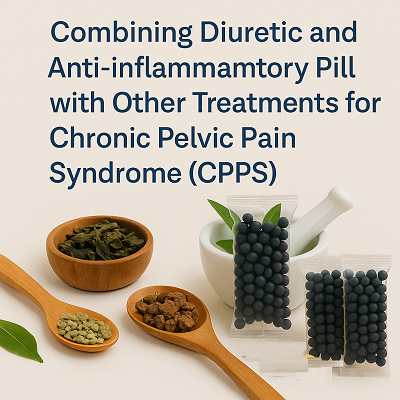Combining the Diuretic and Anti-inflammatory Pill with Other Treatments for Chronic Pelvic Pain Syndrome (CPPS)
Chronic Pelvic Pain Syndrome (CPPS) is truly a frustrating condition. It is mainly characterized by persistent pelvic discomfort and difficulty urinating. Due to its complex causes, it is notoriously hard to treat. Traditional single-drug therapies often fail to deliver satisfactory results.

In recent years, however, the Diuretic and Anti-inflammatory Pill, with its multi-target therapeutic mechanisms, has emerged as a powerful treatment option, showing unique advantages. This article explains how the Diuretic and Anti-inflammatory Pill works and how it can be used in combination with other medications to offer an integrative approach that blends Traditional Chinese Medicine (TCM) and Western medicine. This approach may help patients break through treatment bottlenecks and achieve long-term symptom relief.
What Is Chronic Pelvic Pain Syndrome?
Chronic Pelvic Pain Syndrome is a urogenital condition primarily characterized by chronic pain in the pelvic floor region and urinary dysfunction. Patients often report discomfort or pain in the lower back, perineum, and lower abdomen, sometimes even affecting the testicles. Unlike traditional prostatitis, CPPS is not directly linked to the anatomical structure of the prostate. In 1995, the U.S. National Institutes of Health (NIH) redefined and grouped such complex, symptomatically similar disorders under the term "Chronic Pelvic Pain Syndrome" to improve diagnostic accuracy and facilitate further research.
The exact mechanism of CPPS remains unclear, but it is believed to involve multiple contributing factors. Inflammatory responses in the prostate, neuroendocrine disorders, immune dysfunction, and pelvic floor muscle tension are among the suspected culprits. Once inflammatory cytokines are released, they lead to localized congestion and edema, stimulating nerve endings and causing pain. Neuroendocrine imbalances may affect the function of the bladder and urethra, resulting in abnormal urination. Moreover, immune dysfunction impairs the body's ability to clear pathogens, making recurrent inflammation more likely.
Clinical Challenges:
Treating CPPS is notoriously difficult. The causes are complex and multifactorial, making targeted treatment challenging. The symptoms are often recurrent, discouraging patients and weakening their confidence in treatment. Psychological issues and physical symptoms are often intertwined, further complicating management. Current treatment options include medication and psychotherapy, but monotherapies often fall short. A multi-faceted approach is essential for better outcomes.
Why the Diuretic and Anti-inflammatory Pill Stands Out
The Diuretic and Anti-inflammatory Pill is a TCM compound formula consisting of more than 50 carefully selected herbs, including plantain seed, houttuynia, dianthus, talc, skullcap, angelica, safflower, peach kernel, and others.
Urinary relief: Herbs like plantain seed, dianthus, and polygonum have strong diuretic and stranguria-relieving properties, significantly improving urination difficulties and reducing urethral irritation.
Pain and blood circulation: Safflower, peach kernel, corydalis, and costus root enhance blood circulation, relieve pain, and help eliminate stasis, thereby alleviating pain and distension in the lower abdomen and perineum.
Antibacterial and anti-inflammatory effects: Skullcap, gardenia, forsythia, houttuynia, and honeysuckle target pathogenic bacteria and inflammation at the root, reducing the chances of recurrence.
Immune regulation: The formula includes herbs that enhance the immune system, helping patients build internal defenses to fight inflammation and strengthen the body's resistance.
Anti-hyperplasia and anti-fibrosis: For chronic cases involving prostatic calcification, hyperplasia, or fibrosis, ingredients like vaccaria, peach kernel, honeysuckle, and violet can inhibit abnormal tissue growth, reduce swelling, and clear glandular blockages.
Clinical Advantages:
- Safe and natural: As a pure herbal remedy, it has minimal side effects compared to Western medicines.
- Comprehensive action: Its multi-component formulation tackles CPPS from various angles—relieving symptoms, restoring internal balance, and enhancing immunity.
- Personalized treatment: The formula can be adjusted based on the individual's condition and constitution, allowing for a customized approach aligned with TCM's principles of syndrome differentiation.
How to Maximize Treatment Results through Combination Therapy
1. With Antibiotics: Targeting Acute Infections
If the CPPS is triggered or worsened by pathogenic infection, combining antibiotics such as levofloxacin or cefaclor with the Diuretic and Anti-inflammatory Pill becomes essential. Antibiotics can rapidly reduce bacterial load and acute inflammation, while the herbal pill works to improve urination and blood circulation, restoring internal balance and preventing relapse.
2. With NSAIDs: Rapid Pain Relief
Persistent pelvic pain severely impacts patients' quality of life. Non-steroidal anti-inflammatory drugs (NSAIDs), such as ibuprofen or acetaminophen, offer rapid relief. When used with the Diuretic and Anti-inflammatory Pill, NSAIDs provide immediate symptom control, while the pill addresses the root causes through blood circulation and inflammation reduction. This dual action ensures faster pain relief and longer-lasting results.
3. With Alpha-blockers: Improving Urination
Many CPPS patients suffer from urinary issues like urgency, frequency, and incomplete voiding. Alpha-blockers (e.g., tamsulosin, alfuzosin) relax urethral smooth muscles, improving urinary flow. When combined with the Diuretic and Anti-inflammatory Pill, which promotes urination and reduces glandular pressure, urinary function improves significantly, offering greater comfort to the patient.
4. With Antidepressants: Enhancing Mental Health
Long-term chronic pain can lead to anxiety, depression, and a negative feedback loop that worsens physical symptoms. Selective serotonin reuptake inhibitors (SSRIs) can help regulate neurotransmitters and improve mood. When paired with the Diuretic and Anti-inflammatory Pill, the treatment addresses both physical and psychological aspects, breaking the cycle of pain and distress and improving overall quality of life.
Conclusion
Chronic Pelvic Pain Syndrome is a complex and stubborn condition, but the Diuretic and Anti-inflammatory Pill—whether used alone or in combination with other drugs—has demonstrated notable advantages and efficacy. Strategic combination with antibiotics, NSAIDs, alpha-blockers, and antidepressants can provide a holistic treatment approach that tackles pain, urinary dysfunction, and psychological distress. However, patients should always follow professional medical advice when formulating a combination therapy plan to ensure safe and optimal treatment outcomes.
Ready to start your recovery?
Visit our official website at Diureticspill.com to consult with our experts or learn more about herbal solutions for chronic pelvic pain.



